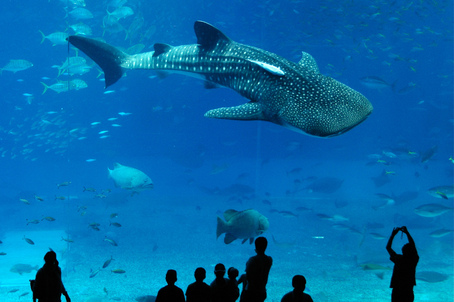 As a reflection back of the several months I have been writing in this blog, I aim to review some of the relevant topics presented and existing in the world today regarding.
Tourism is not a new thing and in the past century has grown immensely with the increased ease of world travel. More individuals travel now than ever before, and it’s not just the rich of the rich. International travel is becoming a way of life. This is great, good and sometimes bad. There are many unique sites in the world and tourism allows cultures and ideas to be spread and understood by the rest of the world. Communication is becoming less of a hindrance. Most nations are welcoming to the tourists, and governments are taking steps to ensure local communities can benefit without dealing unwanted blows to the tourist populations.
However there are still ways to improve tourism. While the world may be mostly peaceful there are a still many places haunted by war, civil unrest, poverty, and natural disasters. It is imperative that tourists be respectful of the cultures they are visiting, encouraging equality, understanding, and conservation. This with help developing countries a great deal to become economically stable, encourage tourism growth and preserve uniqueness of attractions be they animals, landscape, or cultures. A great many vacations can have service opportunities, creating memorable experiences, and help bridge cultural stereotypes.
The decisions we make will determine the fate of countless endangered species, equality between races and nations, build economic prosperity, fostering war or encouraging peace, and ultimately mold the face of the world for the future. Through tourism we each are responsible for the part we play in preserving, building, and ultimately creating a better world.
One man doing a great amount of work can do some good, but, many people working together can move mountains, and that is when the world really changes.
The whale shark is unique, size wise it’s the world’s largest fish, with no known natural enemies. It takes at least 25 years for it grow to maturity and, unlike other fish, is born live like whales. Despite its size it moves slowly, often near the surface of the water. This makes it a popular attraction for aquatic tours all over the world. It is unknown what the whale shark population is, estimates range from 30,000 to over 3 million(Maldives Whale Shark Research Programme). However, these enormous creatures remain elusive and difficult to track because of their migratory behavior; following food sources and ideal ocean temperatures thousands of miles(The Nature Conservancy).
Currently the whale shark is listed by the International Union for Conservation of Nature (IUCN) as vulnerable for extinction, and is most affected by man-made threats. This means that the greatest threats are a result from human interactions. Because whale sharks spend so much time near the surface they often get hit by high speed boats and ships. Besides accidentally getting trapped in fishing nets, they are also hunted illegally which may be the greatest threat to the species. In the long term pollution and rising ocean temperatures ultimately determine whether this species will survive in the wild in the future.
The thought of potentially losing the whale shark to extinction should stir inside everyone some desire to act in support of its conservation. However, too often this thought is followed by assumptions like “I’m only one person. I can’t possibly make a difference.” Or “I don’t live anywhere close, so there isn’t anything I can do.” In reality thoughts like this are the most detrimental to the survival of the whale shark. The fact is there are amazing opportunities small and large for everyone regardless of where they may live. The Maldives Whale Shark Research Programme has volunteer opportunities, conducts research, and works to raise awareness. This and a plethora of other conservation organizations accept donations and provide opportunities for you do your part to protect whale sharks and other endangered species.
But don’t think your first attempt to make a difference needs to be the biggest, start small by using reusable grocery bags, buying less bottled water, recycle, or make small donations to respected organizations. But when you’re ready step it up a notch, check out these sites for opportunities to continue to make a difference.
There are many important and unique places around the world. Some are of historical or cultural significance, others are unique in their natural beauty, environment, or be home to special plant and animal life. The United Nations Educational, Science and Cultural Organization (UNESCO) created the World Heritage Convention to identify and help preserve these sites.
When a site is identified the 5 goals of UNESCO are to; 1) help collaborate, 2) discovering how tourism and the communities surrounding a site fit together, 3) encouraging the development of programs for individual sites that create a newness of life, 4) focusing on authenticity and quality, and all of this of course is done to 5) preserve and protect the resources of the landmark.
One landmark that was added to the list of world heritage sites is Coro, a coastal city and shipping port in the Caribbean country of Venezuela. Founded in the early 1500s, this city has a rich history of Spanish and Dutch influence. Its Christian heritage runs deep and is present in the plethora of religious architecture and buildings.
Coro and its Ports was originally inscribed to the list of World Heritage Landmarks in 1993 but was upgrade to the list of World Heritage in Danger in 2005. This was due to increased threats from heavy rains in late 2004 through early 2005 and inappropriate construction damaged both integrity and historic authenticity of the landmark.
While the site is known to hold great historic treasures there is a lack of progress by the local governments to develop a goals that will preserve Coro for both short and long term. Other problems include the lack of a buffer zone between the bustling city and the landmark, there still seems to be some confusion as to how the community and tourism can include the landmark without causing damage to the site. When those plans are finalized then it will likely include programs that restore areas and buildings to previous splendor. Doing so will allow some in the community to find profit in greater tourism, and cultural pride. But any progress made has been slow. The city of Coro has a long road ahead until it is able to maintain itself as world heritage landmark; currently Venezuela is considered one of the least friendly countries in the world (http://www.cnn.com/2013/03/14/travel/friendly-countries).
| | In contrast the Ningaloo Coast in Australia is also a World Heritage site that was officially added in 2011 and has one of the longest near-shore reefs in the world. The marine life is diverse with the whale shark and sea turtles being some of the most famous. Unique to land part is the network of subterranean water bodies, consisting of caves, conduits and streams; supporting a diverse group of rare species.
The Ningaloo Coast is a recent addition to the list of world heritage sites, and therefore, still in the early stages of completing the 5 goals. Among the first is the assembly of committee to collaborate development of programs that will help to continue the integration of the community and tourism in the area while preserving the resources and habitat. Tourist companies in the area are already closely monitored and regulated, but offer worthwhile experiences to tourists. Marine and land tourism is unique, Ningaloo reef is in great condition and local tribes have long been preserving the land sections.
Although the Ningaloo Coast threats include ocean pollution, off-shore oil drilling, rise in ocean temperature, and over-trafficking from tourism. Steps have already been taken to monitor and preserve this landmark successfully for the future. |
Ningaloo, its fun to say out-loud, try it... Ha, that person next to you thinks you're pretty weird right now. The Ningaloo reef is located just off the west coast of Australia home to a rich aquatic life, including our favorite, the whale shark. While there are a plethora of companies that advertise unforgettable experiences, there are few that match those at Ningaloo Whale Shark-n-Dive when comparing credibility and quality of adventures. The hard part for you may be deciding which adventure to do first, but honestly, they have the more difficult task of maintaining fair-trade and Eco-tourism business practices while giving you some unbelievable experiences.
It may seem a little time consuming at first but the effects of fair-trade and Eco-tourism are not necessarily things you will notice in your first visit to Exmouth. Those effects will be seen ten, 20, and 50 years later as you and others revisit. It will be on your second and third visits that you'll notice how much the coral has grown, and how the local culture is proudly displayed in local shops and business.
When you're there you'll see Ningaloo Whale Shark-n-Dive and their implementation of these fair-trade practices:
Fair Working Conditions - This company seeks employees and services found in the local community.
Fair Prices - The adventures offered include pick-up and drop-off from your hotel, water and soda for the day, snacks, a meal, any instruction needed. This means there is less for you to worry about and allows the experience to be less stressful and more memorable. Adventures are available to all despite skill level, even offering PADI dive certification.
Integration Into the Local Economy and Regional Development - Whenever possible Ningaloo Whale shark-n-dive buy products and services from businesses in the local community. This means for the most part the money you spend stays to help build the local businesses and promotes the maintaining of local traditions and culture.
Fair Trade Partnerships Between All Actors in Tourism - Because the adventure includes pick-up and drop-off from local hotels this encourages you to stay in the community promoting other local businesses and lets you to spend your money within the community.
Sustainable Resource Use and Environmental Justice - By using Eco-friendly cleaners and soaps, and practicing proper underwater etiquette they help to maintain the beautiful underwater world that you'll enjoy for years to come. This commitment is also shown with their use of efficient watercraft thereby reducing pollution and reducing their carbon footprint.
Their website is great, check it out here; ningaloowhalesharkndive.com
I grew up in a family that was very different from that of my wife's. I know, because she tells me whenever we visit my family. Growing up my dad's idea of a vacation was a nice long road trip. We didn't ever fly because it can grow expensive when purchasing plane tickets that include two parents and twelve kids (although I'm pretty sure we could have packed at least 3 of them in the luggage). So we drove, we drove all over Utah, we drove across Wyoming, we drove to Nevada, we drove through Idaho, we even ended up in South Dakota once. We spent countless hours in the car as a family, by the time we got back home we were so happy to be out of the car we actually started talking again. While those vacations may have been boring compared to today's standards, they are still "something I'll never forget."
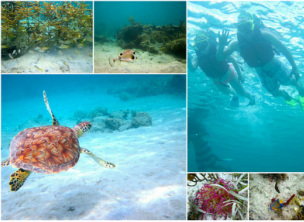 Mckae and I swimming with sea turtles In fact, if you ever make it down to Isla Mujeres in Mexico, you'd likely end up seeing more than one whale shark. Whale Sharks Tours operated by Searious Diving is one of the few companies with permits for whale shark tours in that area. While on the daylong adventure your local guides will share with you there enthusiasm and devotion to to whale shark and ocean conservation. Snorkeling in the open sea and swimming along-side the greatest of all fishes will provide that once-in-a-lifetime experience you can't possibly forget. Tours operated in the Isla Mujeres region are highly regulated and Searious Diving strictly adheres in an effort to protect ocean-life maintain and promote conservation and Eco-tourism for local culture and ocean life. You will likely be more conscious of your own efforts to live green after this experience. On your flight home you'll sigh with disbelief and think; that was "something I'll never forget." | My latest vacation was this past October, my wife and I splurged and went to Puerto Rico. It was amazing, of course. We zip-lined through the rain forest, spent time in the Caribbean beaches, and even swam with Sea Turtles. These adventure tours were provided by local Tour companies, our guides were locals with knowledge about the culture, habitat, and wildlife. There are a great many vacations spots around the would that would allow you that adventure without being detrimental to the environment, this is called Eco-tourism.
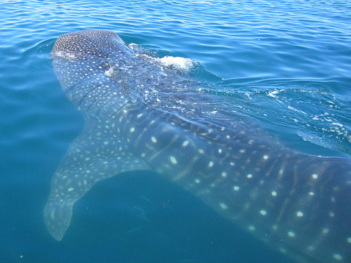 Whale Shark |
The R hincodon typus, is a big shark, some have been seen as long 50 ft., that’s as long as a school bus ("whale shark." The Columbia Encyclopedia, 6th ed.. 2012). The whale shark is the largest of all fishes ( “whale shark.” Encyclopedia Britannica., 2012.), so they don’t have a lot to be afraid of. They look like sharks, have a lot of teeth like sharks, but aren’t scary like the Great White or Tiger sharks. They are actually rather harmless, spending most of the day eating plankton. Whale sharks have their mouth is at the front of their head; to eat it opens wide, sucking in water, filtering it through their gills and swallowing the collected food ("whale shark." The Columbia Encyclopedia, 6th ed.. 2012). Even though these massive creatures have little to fear, there aren’t as many as there used to be. If this keeps up the whale shark will living with the Dodo birds, which are not living at all. In future weeks I hope to share more about this giant of fishes, be sure to check back later to read more for more. Citations: "whale shark." The Columbia Encyclopedia, 6th ed.. 2012. Retrieved February 07, 2013 from Encyclopedia.com: http://www.encyclopedia.com/doc/1E1-whalesha.html “whale shark.” Encyclopedia Britannica. 2012. Retrieved February 07, 2013 from Britannica.com: http://www.britannica.com/EBchecked/topic/641437/whale-shark | 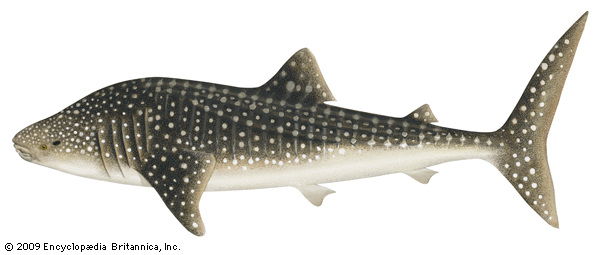 The Whale shark brown-gray with white spots and light underside. 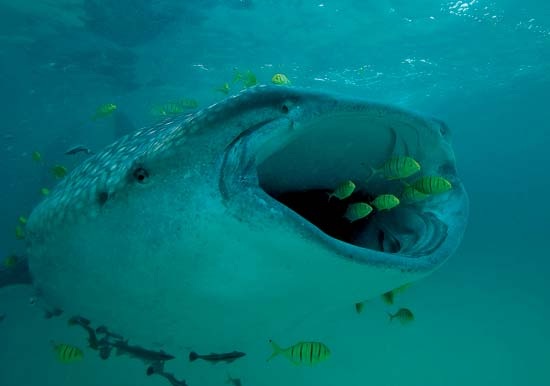 Whale shark feeding. |
|

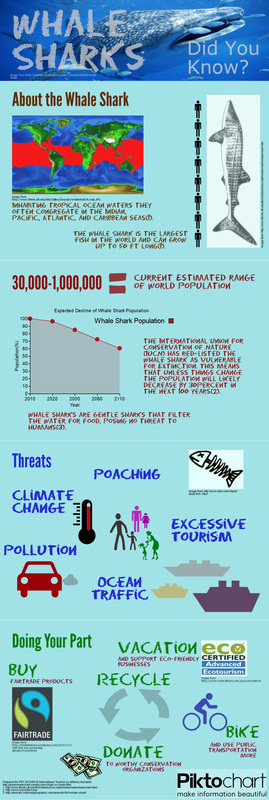

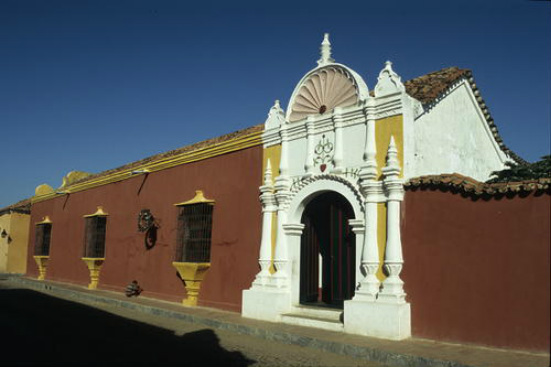
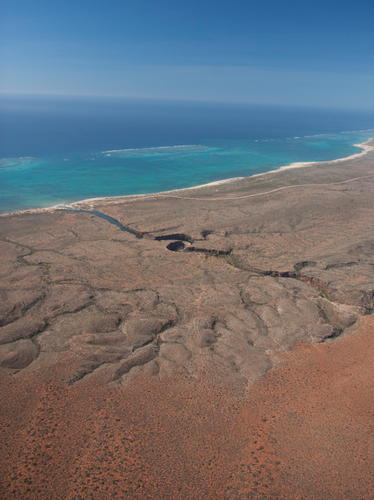





 RSS Feed
RSS Feed